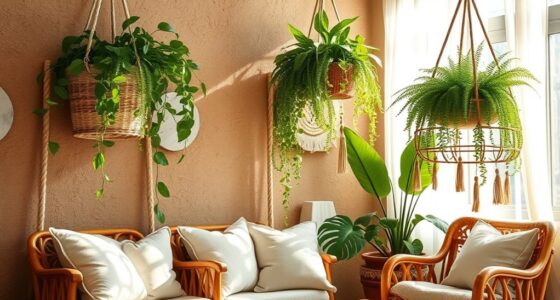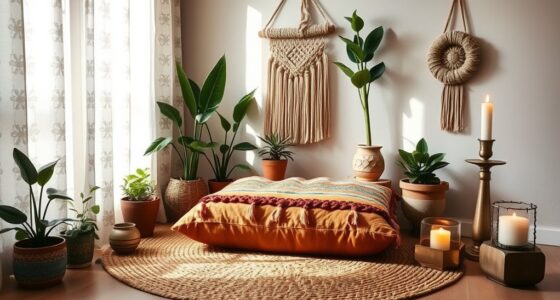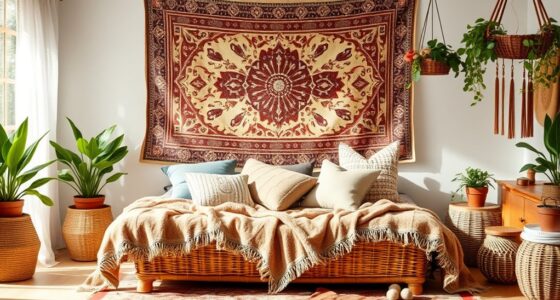To blend boho with other styles, start by balancing vibrant, eclectic colors with neutral tones to create harmony. Arrange furniture in a relaxed, layered layout that encourages coziness, mixing vintage pieces with modern elements. Use accessories like woven textiles and patterned pillows to highlight boho’s charm, while pairing them with sleek or industrial lighting for contrast. Thoughtful placement and balance are key—continue exploring to discover how all these elements come together seamlessly.
Key Takeaways
- Use a cohesive color palette by blending vibrant boho hues with neutral tones to create harmony.
- Arrange furniture to balance relaxed boho layouts with structured styles for a natural flow.
- Incorporate contrasting accessories like modern art or industrial lighting to highlight each style’s uniqueness.
- Mix textures and materials, such as rattan and sleek metals, to add visual interest and cohesion.
- Plan your overall layout thoughtfully to ensure styles complement rather than compete for a unified look.

Blending boho with other interior styles offers a creative way to personalize your space and make it uniquely yours. When you start mixing these styles, one of your first considerations should be the color schemes. Boho is known for its vibrant, eclectic palette—think deep jewel tones, earthy neutrals, and pops of bright hues. To successfully blend it with another style, like Scandinavian or industrial, you should balance these bold colors with more subdued tones. For example, if you’re pairing boho with modern minimalism, opt for a neutral base—whites, grays, or soft beiges—and add colorful boho accents through textiles, art, or decorative accessories. This approach keeps the space lively without overwhelming the senses.
Blending boho with other styles creates a vibrant, personalized space through balanced color schemes and thoughtful decor.
Furniture placement plays a vital role in integrating boho with other styles seamlessly. In a boho-inspired room, furniture is often arranged in an inviting, relaxed manner, with layered seating and an emphasis on comfort. When you combine it with a more structured style, like mid-century modern, you want to preserve that organic flow while maintaining an organized look. Place a plush, patterned boho rug in the center of the room and arrange furniture around it in a way that encourages conversation and coziness. Mix vintage or rattan pieces with sleek, clean-lined furniture to create an interesting contrast. You don’t need to be rigid; instead, aim for a balanced layout that feels natural and inviting.
You can also play with the placement of accessories to emphasize the blending of styles. Incorporate boho textiles such as fringed throws, patterned pillows, and woven wall hangings alongside modern art or industrial lighting fixtures. Position furniture in a way that highlights these contrasts—perhaps a rustic wooden coffee table paired with contemporary metal chairs, or a vintage armchair with a sleek, minimalist side table. This combination creates visual interest and highlights the unique qualities of each style without making the space feel chaotic.
Additionally, considering the overall interior layout can help in creating a harmonious blend, ensuring that each style complements rather than competes with the other. Ultimately, blending boho with other interior styles is about creating harmony through thoughtful color choices and strategic furniture placement. Use color schemes to unify disparate elements, and arrange furniture and accessories to foster a cozy, cohesive atmosphere. When you pay attention to these details, you craft a space that’s not only stylish but also feels authentic and personalized. The key is to experiment and trust your instincts—your space should reflect your personality while beautifully merging different design influences.
Frequently Asked Questions
Can Boho Style Work in Small Apartments?
Yes, boho style can work in small apartments. You can maximize space by choosing space-saving furniture like multi-functional pieces and vertical storage. Incorporate wall decoration tips, such as hanging tapestries or plants, to add boho charm without cluttering your space. Focus on light colors and strategic decor to create a cozy, relaxed vibe. With thoughtful placement, boho elements transform small areas into inviting, stylish retreats.
How Do I Incorporate Modern Elements Into Boho?
To incorporate modern elements into your boho space, start with industrial accents like metal light fixtures or furniture to add an edgy vibe. Use contemporary textiles such as sleek cushions or rugs with geometric patterns to contrast the relaxed boho feel. Mix these elements thoughtfully with your existing decor, balancing textures and styles, so your space stays cohesive and inviting while showcasing both boho charm and modern sophistication.
What Are Common Color Schemes for Boho Blends?
When choosing a color palette for your boho blend, you want shades that create a warm, inviting vibe. Earth tones like terracotta, ochre, and olive green work well, complemented by vibrant accents like turquoise or coral. These colors foster design harmony by balancing bold and neutral tones. Incorporate patterns and textures to enhance the layered look. Always keep your personal style in mind to make your space feel authentic and cozy.
Is Boho Suitable for Minimalist Interior Designs?
You might find boho suits minimalist interiors if you focus on selective boho accessories and vintage furniture. Incorporate neutral tones, clean lines, and simple decor, then add textured boho elements like rugs or cushions sparingly. This blend creates a cozy, eclectic vibe without overwhelming the space. The key is balancing the relaxed, artistic boho feel with the sleek simplicity typical of minimalism.
How Do I Balance Clutter With a Boho Aesthetic?
To balance clutter with a boho aesthetic, focus on clutter management by choosing a few statement pieces and organizing smaller items in baskets and trays. Keep your space feeling relaxed yet curated by maintaining an aesthetic balance—avoid overcrowding, and leave room for breathing. Incorporate natural textures and layered textiles thoughtfully, ensuring your boho vibe remains inviting without feeling chaotic. This approach keeps your space lively and stylish, not cluttered.
Conclusion
As you blend boho with other styles, you’ll discover that harmony often emerges from unexpected combinations. Just like fabrics woven together create a unique tapestry, your space becomes a reflection of your evolving personality. Sometimes, the most surprising pairings reveal the deepest beauty—reminding you that mixing styles isn’t just about aesthetics, but about embracing life’s delightful unpredictability. Trust your instincts, and let your home tell a story that’s uniquely yours.










